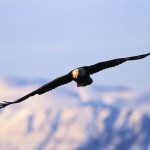As I stepped out of my car and onto my driveway, I looked up into the clear, blue sky and spotted a beautiful, large bird of prey. This hawk was sailing in the expanse above, in that familiar circular motion. Without flapping its large wings at all, the bird floated in a large circle a few times. Soon, the hawk gracefully made its way to yet another area of spherical pattern; it did so seamlessly. One second the creature sailed in one circle, and the next second it veered slightly to begin rotating around the next pattern. At no point in the transfer did the bird ever beat its wings. Amazingly, I watched as the creature continued in this endeavor for more than five minutes, riding from one circle to another, until the bird was on the other side of the sky and nearly out of sight. Not once did it flap its wings!
“How graceful,” I thought. As a bird lover, I recognized what was happening. The hawk was engaged in thermal soaring. This flight technique depends on thermal updrafts, which are defined well by Perrins and Elphick (2003), “As the ground warms up in the morning sun, more energy is absorbed by some features than others. This causes the air locally to heat up, forming an invisible, rising bubble. As it rises, more air is sucked in and heats up, and it too rises” (p. 18). The bird I observed that day was literally soaring from updraft to updraft. The hawk migrated by gliding from warm air bubble to warm air bubble – and nearly effortlessly. I cannot even estimate the area it covered without ever flapping its large wings.
This hawk is a bird of prey, as is the eagle. These birds of prey – with long, broad wings – are often known for thermal soaring, an efficient way to travel. As I watched that winged creature in the sky at my home, God struck my heart with thoughts of security. He reminded me of Isaiah 40:31 (NIV), “But those who hope in the LORD will renew their strength. They will soar on wings like eagles, they will run and not grow weary, they will walk and not faint.” Why did God mention the eagle here? Perhaps because God means for us to realize we need not frantically flap our own wings as smaller birds do!
The thermal updraft on which we are to securely glide is the warm strength of the Holy Spirit. His power and love are what fills our hearts and provides our way to ride from experience to experience in this life. We need not rapidly or desperately beat our wings to make things happen; our Lord carries us by His own presence. The Holy Spirit is the third Person of the Trinity, fully God. He remains with us here on this earth to guide, comfort, and provide. No matter what “circle” we transition to, it is the Holy Spirit who carries us. Our responsibility is to stay close to Him, listening to Him as He shows us where to glide next. We can take time to hear Him and fellowship with Him, because our energy is not wasted in frenzied movement. We are still, and we know that He is God (Psalm 46:10). We spread our wings and ride on God’s strength, and we wait for the day the sphere to which we transfer will be on the updraft to our heavenly home. He will take us there, too.
Reference: Christopher M. Perrins & Jonathan Elphick. The Complete Encyclopedia of Birds and Bird Migration. (Edison, NJ: Chartwell Books)

